RDA: Resource description and access part 1 - Joint Steering ...
RDA: Resource description and access part 1 - Joint Steering ...
RDA: Resource description and access part 1 - Joint Steering ...
- No tags were found...
You also want an ePaper? Increase the reach of your titles
YUMPU automatically turns print PDFs into web optimized ePapers that Google loves.
5JSC/<strong>RDA</strong>/Part I/CILIP response5JSC/<strong>RDA</strong>/Part I/Chapter 3/CILIP response20 March 2005p. 2This wider viewpoint will not be much in evidence elsewhere in this response, but its absenceshould be taken as no more than a reflection of where our collective talents tend to lie.Optionality. Some concern has been expressed within CILIP about the degree of optionalityencountered in the draft of Part I. This is not just to do with the frequency of use of the term“optionally” is to be found, but also of the types of situations in which optionality is offered. TheCILIP view is that some cases simply work against st<strong>and</strong>ardisation (for example, the variousoptions in something as fundamental as 1.6). At some point the need to reach out to othercommunities has to be balanced against the need for clear direction to our own community.Would the former be better achieved, for example, by some sort of <strong>RDA</strong> lite, in which theprinciples <strong>and</strong> concepts could be conveyed to other communities in a helpful <strong>and</strong> meaningfulway, whilst at the same time having a more rigorous code for our own community that recognisesmore fully the benefits to users of st<strong>and</strong>ardisation.CILIP would also welcome some variation in terminology. Currently it seems as though“optionally” is used in three quite different situations:• where the option is to do less than the rule states;• where the option is to do more (i.e. go into more detail) than the rule states;• where the option is to do something different from what the rule statesWe doubt it helps to use the same term for all three situations (although (a) is probably foundonly rarely). Type (c) is really an alternative masquerading as an option; perhaps it would beclearer to record it as such?Organisation. The organisation by area of <strong>description</strong> rather than type of material certainly saveson the need to flip back <strong>and</strong> forth between different chapters in the printed version of <strong>RDA</strong>, butother aspects of the organisation extend this need, e.g. Appendix D. It is hard at this early stage toknow how the change in organisation will affect cataloguing in the real world. As the success of<strong>RDA</strong> depends largely on its acceptance by the cataloguing community - which in turn will beaffected by its ease of use - it seems that effective testing in real-life cataloguing situations of theorganisation of the code will be essential.Separation of content <strong>and</strong> presentation. A number of comments were submitted to CILIPshowing that, despite JSC’s best efforts, the fundamental point about separating rules for thecreation of content from those concerned with presentation of that content to the user had notbeen fully grasped. Placing the rules for “Publisher, Distributor, etc.” (a m<strong>and</strong>atory element asdefined by 1.5) before those for “Place of Publication, Distribution, etc.” had led somecorrespondents to assume that this was how they should be presented. The same goes for the wayrules governing the provision of notes form <strong>part</strong> of the rules for the element for which the note isrequired rather than, as with AACR, being gathered together in one block towards the end of achapter. Whilst this is of only tangential relevance in the immediate context of this response tothe Part I draft, it does serve to highlight the degree of commitment to education <strong>and</strong> training thatwill be required to support the implementation of <strong>RDA</strong>.The one presentation feature that has survived into the body of <strong>RDA</strong> is the use of square bracketsto indicate “information taken from outside the resource itself” (Outcomes of the October 2005JSC meeting). This seems to be confusing content with metadata about the cataloguing itself. Itmight be better to encode such “meta-metadata” rather than to embed it in the content. Forexample, MARC indicators could be used to indicate that the content of a tag is taken from




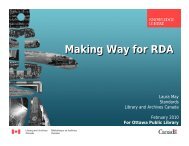
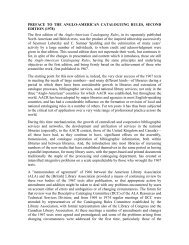
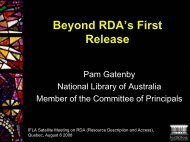

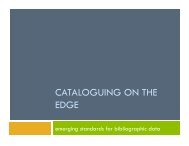

![Presentation slides [PDF] - Joint Steering Committee for ...](https://img.yumpu.com/41621230/1/190x143/presentation-slides-pdf-joint-steering-committee-for-.jpg?quality=85)

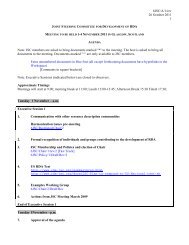
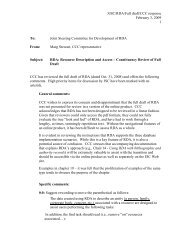
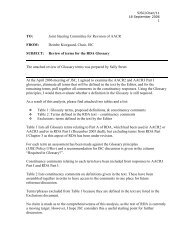
![Presentation slides [PDF] - Joint Steering Committee for ...](https://img.yumpu.com/35256207/1/190x143/presentation-slides-pdf-joint-steering-committee-for-.jpg?quality=85)
